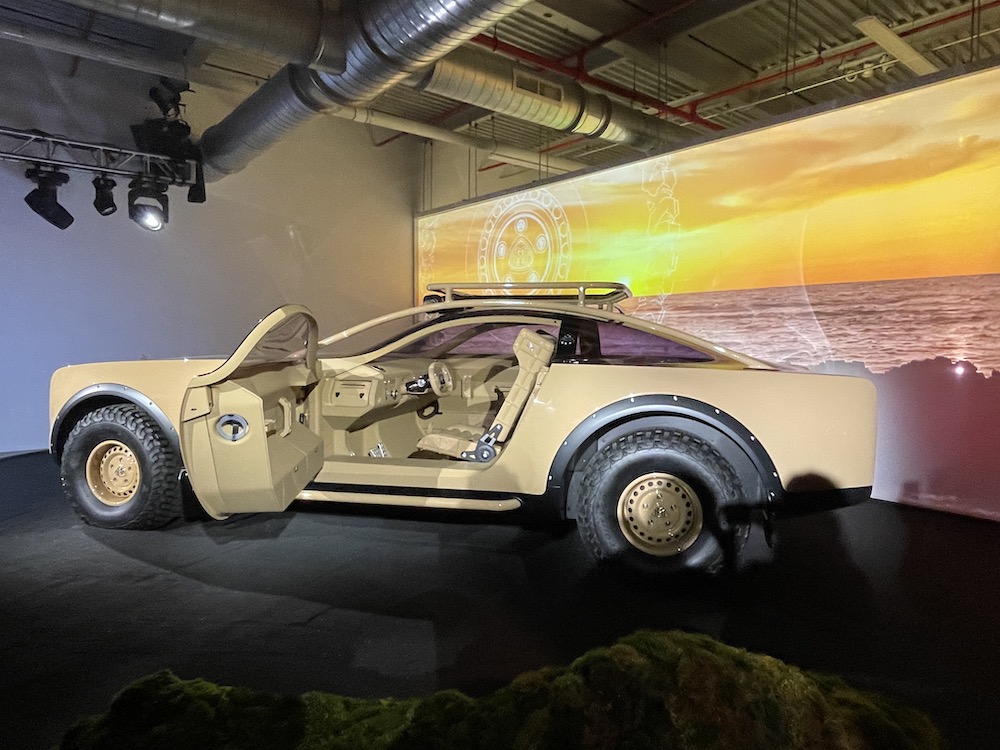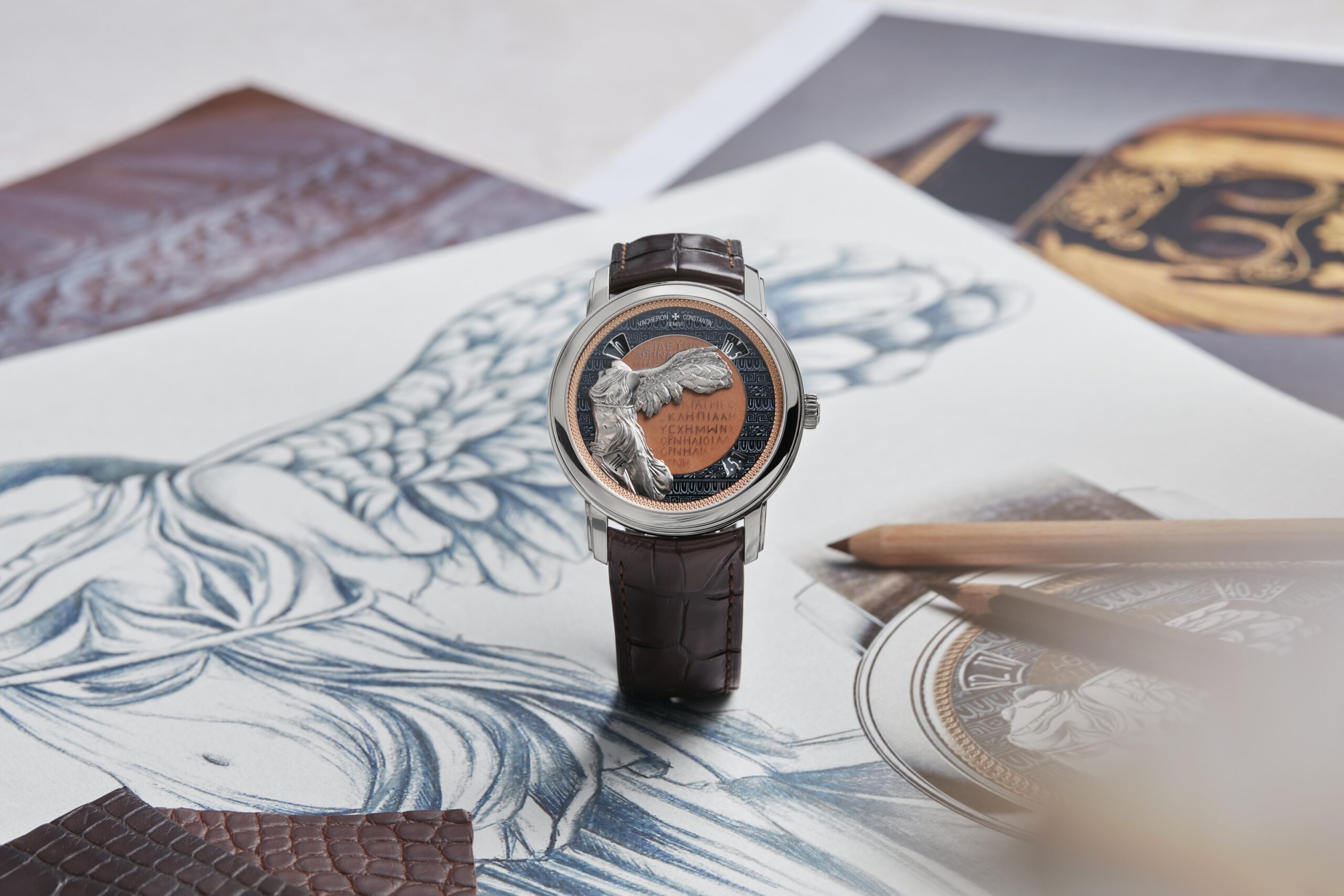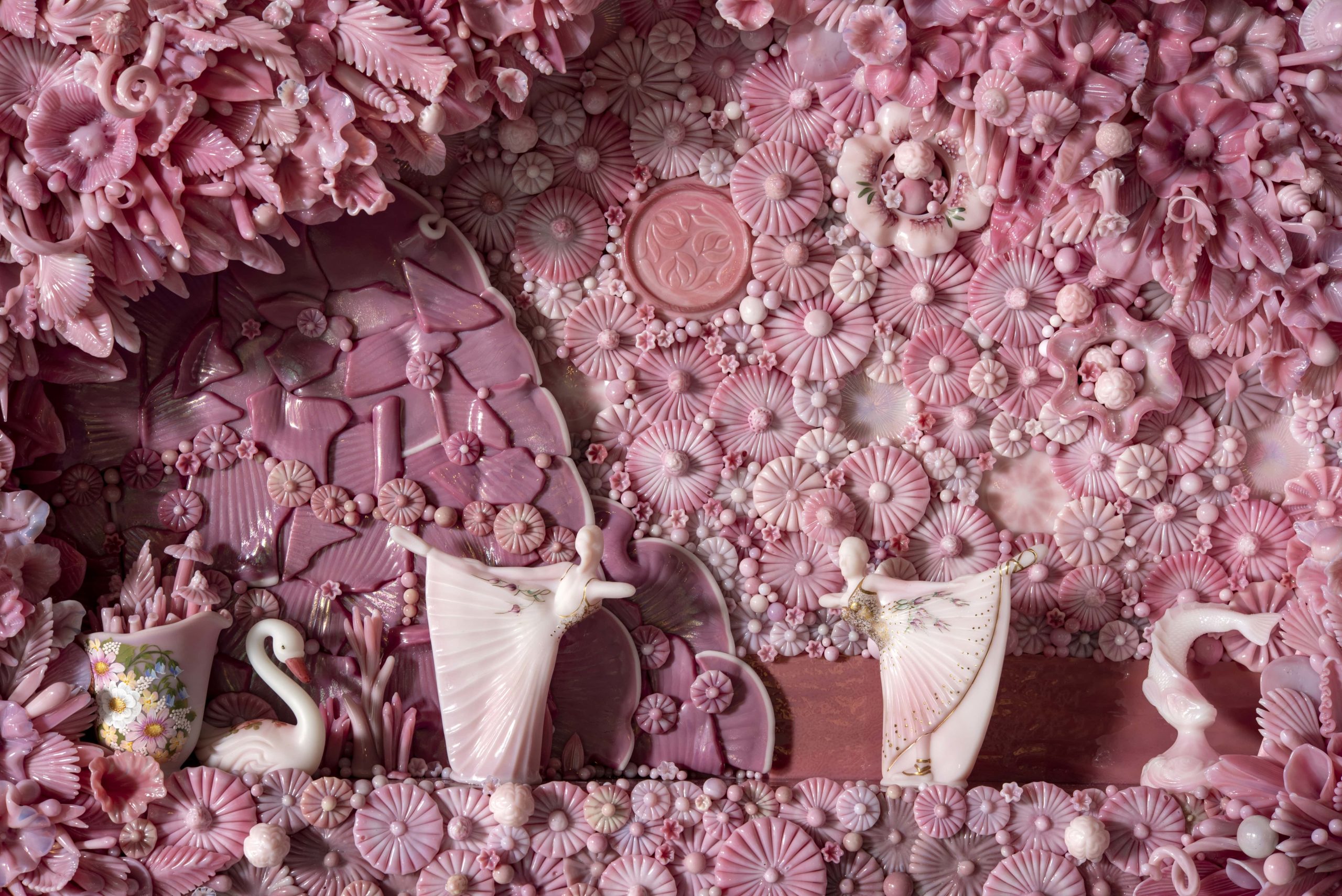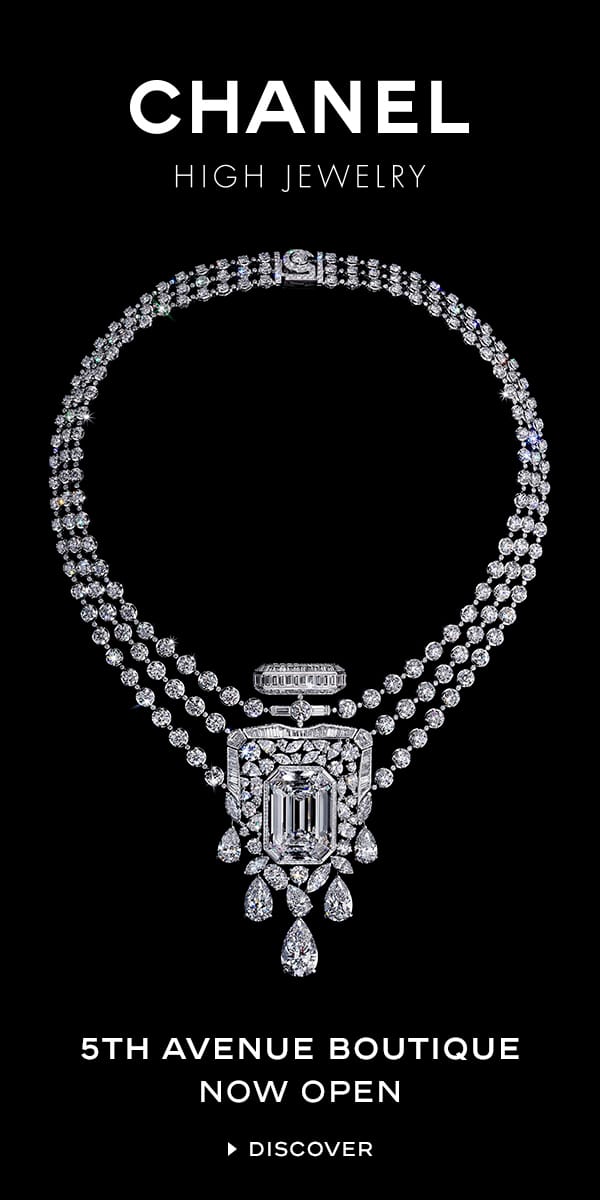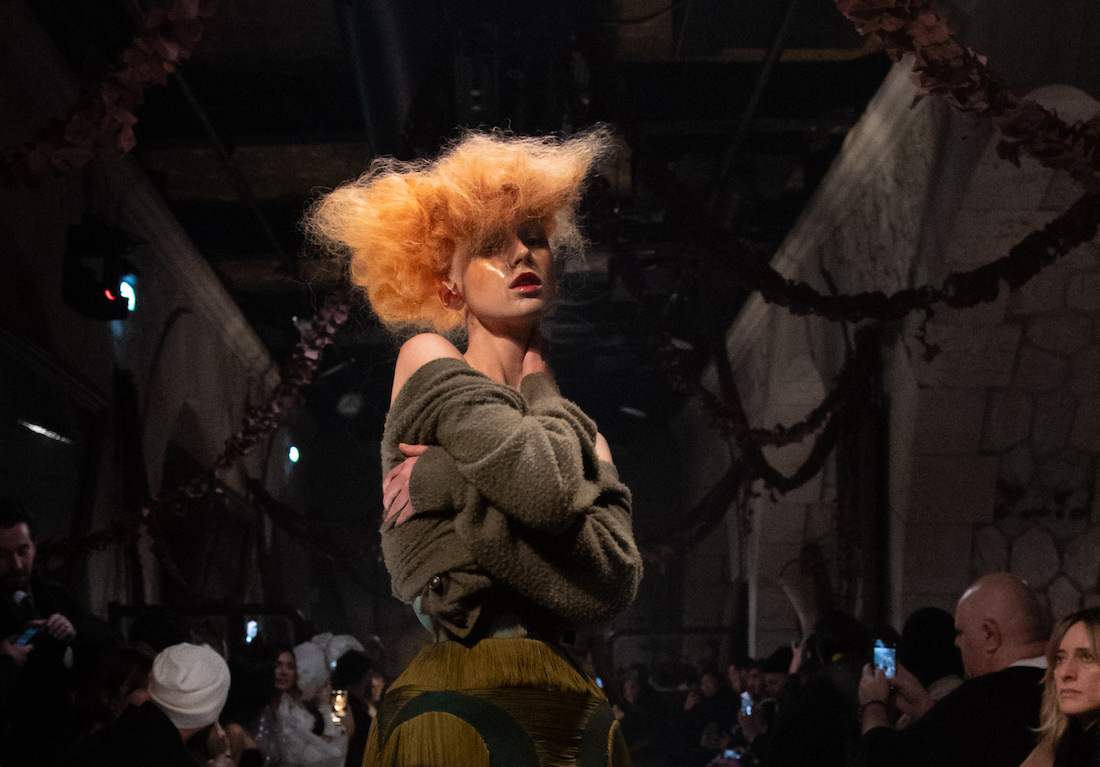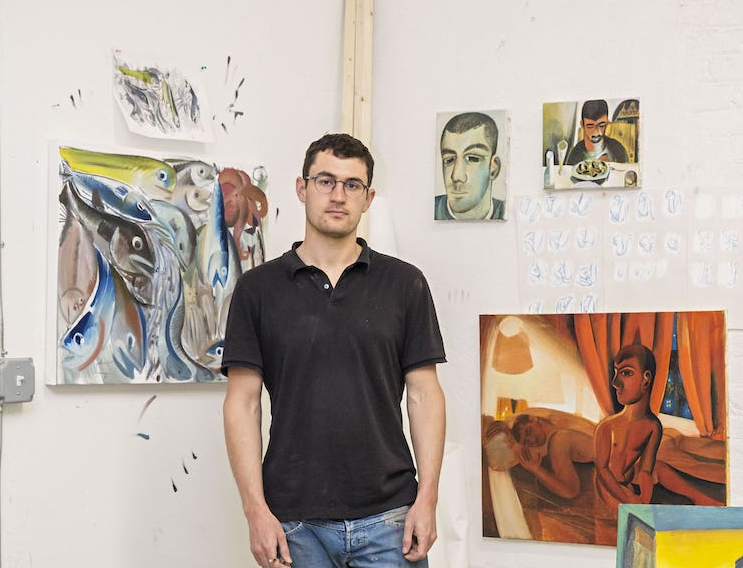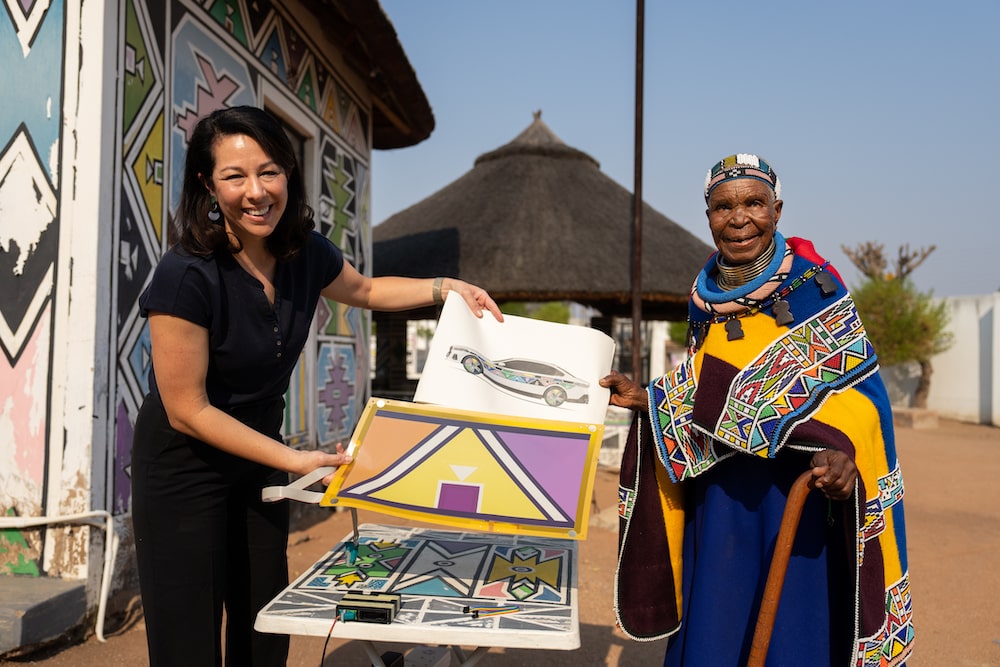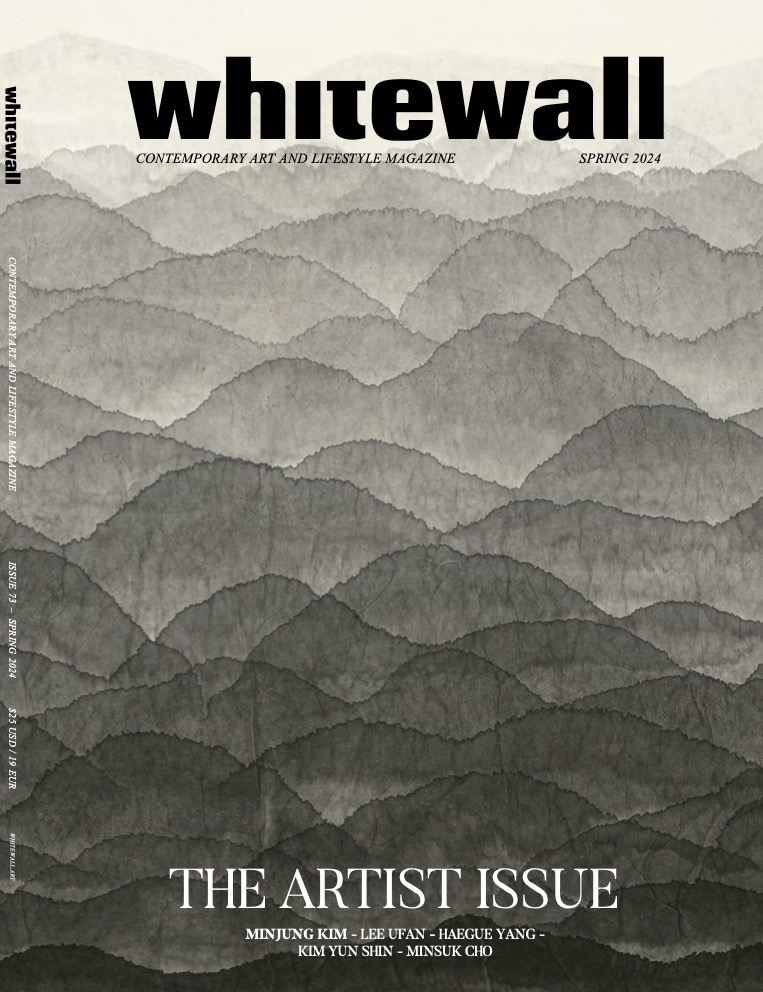Amber Cowan’s glass works are a feast for the eyes. Rich in monochromatic, dreamy colors, they are filled with figures, flora, and fauna, overflowing in a scene that she’s carefully orchestrated, piece by piece. Each starts with finding a color or object in antique pressed glass, be it from now-closed factory deadstock, eBay, or elsewhere. Sometimes Cowan is inspired by the story of a decorative piece, like the Crown Tuscan Flying Lady bowl by Cambridge Glass, featuring a nude woman based on a famous trapeze artist with arms stretched back around a large shell bowl. Other times, she creates a story of her own, as with the perilous fate of two swans in Bubble Bath in the Tunnel of Love.
The immersive, diorama-like pieces draw you in, first with rich colors, then with a faint recognition of something you might have seen growing up in your grandmother or great-aunt’s home. They play with the reimagined possibility of what’s meant for the domestic space or what was once labeled overfeminine.
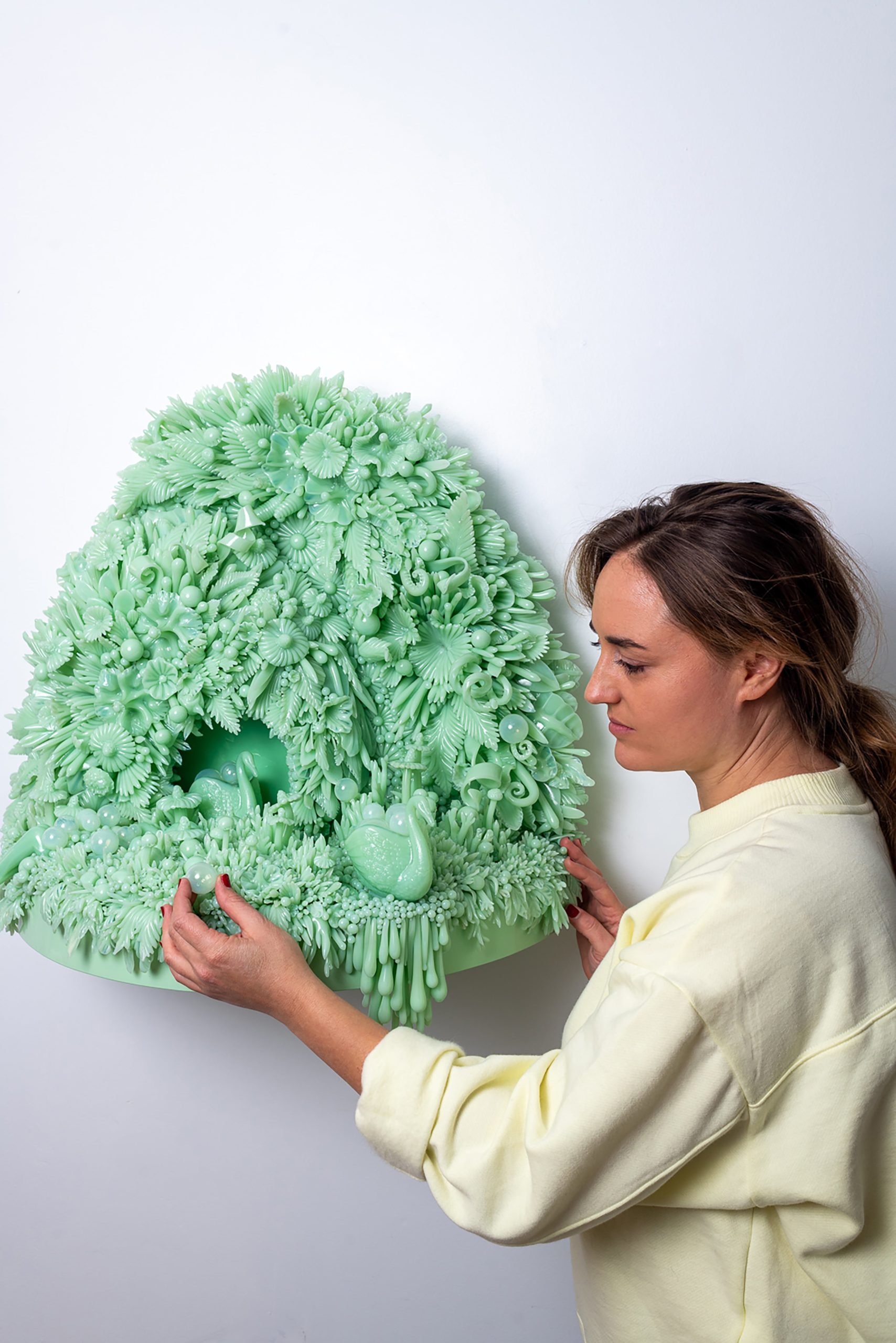
Amber Cowan with Bubble Bath in the Tunnel of Love, 2020, photo by Constance Mensh.
Whitewall recently visited Cowan in her studio, where shelves were filled with antique pressed glass vessels, sculptures, and figurines. Barrels of glass cullet were separated by color, with a station for flameworking in the back. She was working on a commissioned piece for Maison Margiela, in partnership with Dazed, inspired by the fashion house’s recent couture collection. There, we spoke with the artist, whose work is currently on view in “Craft Front & Center” at the Museum of Arts and Design in New York through February 13, 2022.
WHITEWALL: Your use of deadstock and American pressed glass started out of necessity, looking for more affordable materials. What kept you interested in working with it?
AMBER COWAN: I started finding this material in grad school. It was more that I had figured out my style of working, and I was running out of money and material. I found this dumped-out barrel of rabbits, chickens, and candy dishes. It started, really, the whole journey of using this old material. Technically, the glass works like the glass I was trained to use. I’m trained in a Venetian style of glassblowing.
WW: So it was a happy discovery.
AC: Yes, and once I started using the material, it was like this door opened and I started getting into the stories of the pieces, stories of the colors I was using, as well as the history of the glass industry in the U.S.
I knew a little bit about the history of American glass, but really when most people think of artistic glassmaking in the U.S., or glass art, they think of the Studio Glass movement, which started in the sixties. That was when the artist took the glass out of the factory and into the artists’ hands. But what happened before that, what happened in the factory, I wasn’t as familiar with. So I started getting into more.
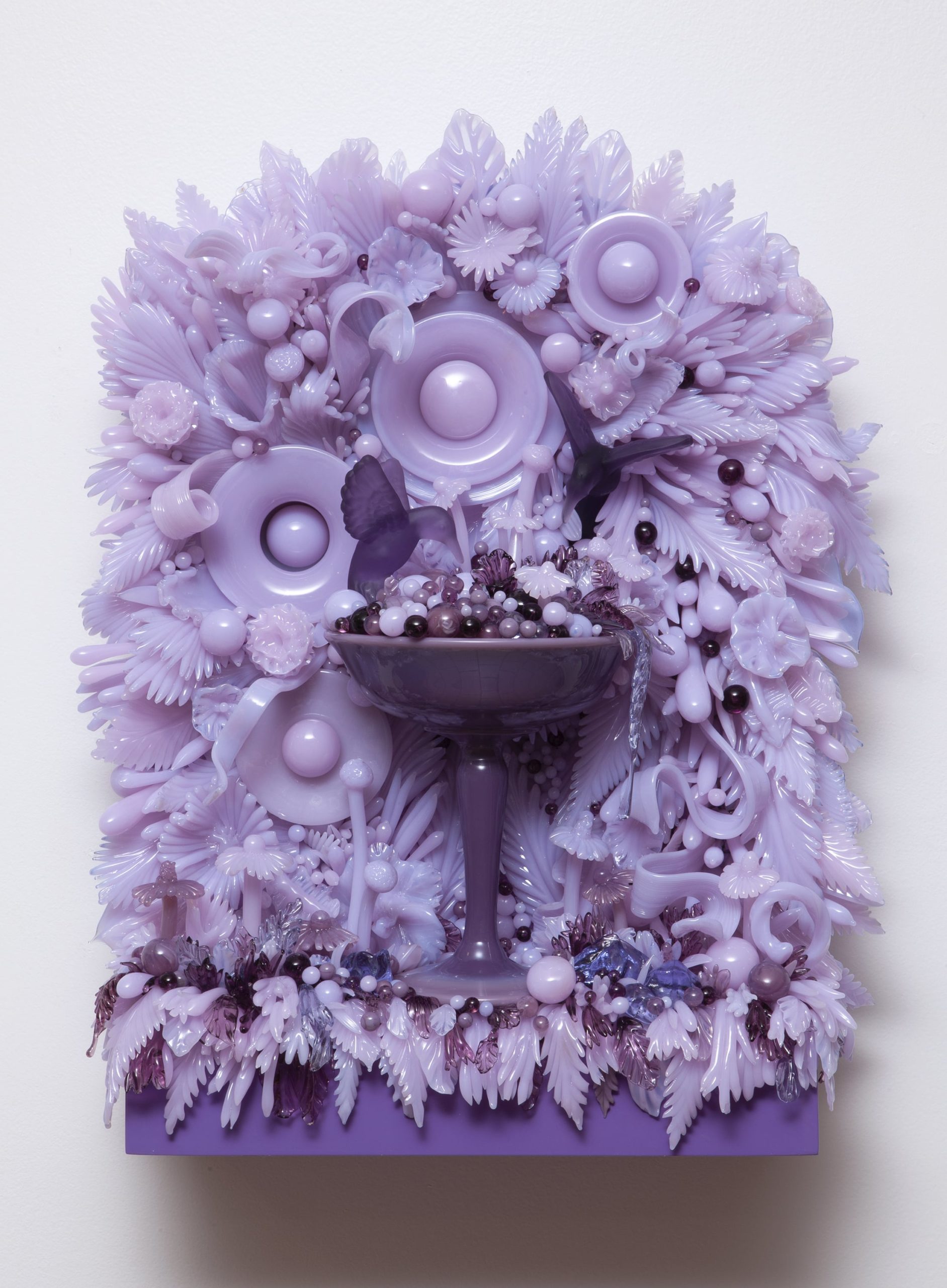
Amber Cowan, “Hummingbirds Feast on Helio and Lavender,” 2021, 20 x 15.5 x 7.5 inches, glass, Mixed Media, photo by Matthew Hollerbush, courtesy of the artist.
WW: How do you source the cullet material?
AC: I go a couple times a year, search through stuff at a yard. I take a lot of samples back, see if I like the color, see if they work right for me.
WW: I love your titles, like Dance of the Pacific Coast Highway at Sunset. How do you start a piece?
AC: How I start usually is finding the color, and then starting to scout what pieces were originally made in that color, to see what kind of material I have to work with. I make all these tiny parts, and then when I’m detailing a piece, all these get filled in, so everything looks really tight. I have this whole library of shapes that I make and produce to build my stock. Glass wants to be and look organic. So those are kind of the forms that I come up with and invent.
WW: Do the backstories of the antique objects ever influence the final piece?
AC: Yeah. I found out one piece was made as an homage to the dancer Isadora Duncan, who was killed by her scarf in a freak accident in a convertible. She was a really famous contemporary dancer. And that piece came out while she was still alive. They produced it for years, and I’ve used her a couple of times.
And some other stories are from people who read about my work, and they send me things. I get a box almost once a month from a stranger. There’s a piece I made that has this blue candy dish at the bottom. A woman sent me this piece. Her great-grandfather won the piece at a state fair in 1876 or something and gave it to her great-grandmother as an anniversary gift. I have a lot of stuff like that.

Amber Cowan, “Fountain in Rosalene,” 2021, 17 x 8.5 x 8.5 inches, photo by Matthew Hollerbush, courtesy of the artist.
WW: Your work was recently on view in the R & Company “OBJECTS: USA 2020” show. Can you tell us about that piece, Bubble Bath in the Tunnel of Love?
AC: I had this idea in my head for that old-fashioned carnival ride, the Tunnel of Love. These swans are coming out of the tunnel, full of hope, naive to the fact they’re about to plunge over the side of this cliff. The girl is just lounging in bliss not thinking about the fate of the swans.
A lot of my work has these themes of love but also of bursting of that bubble, with homages to the power of the feminine.
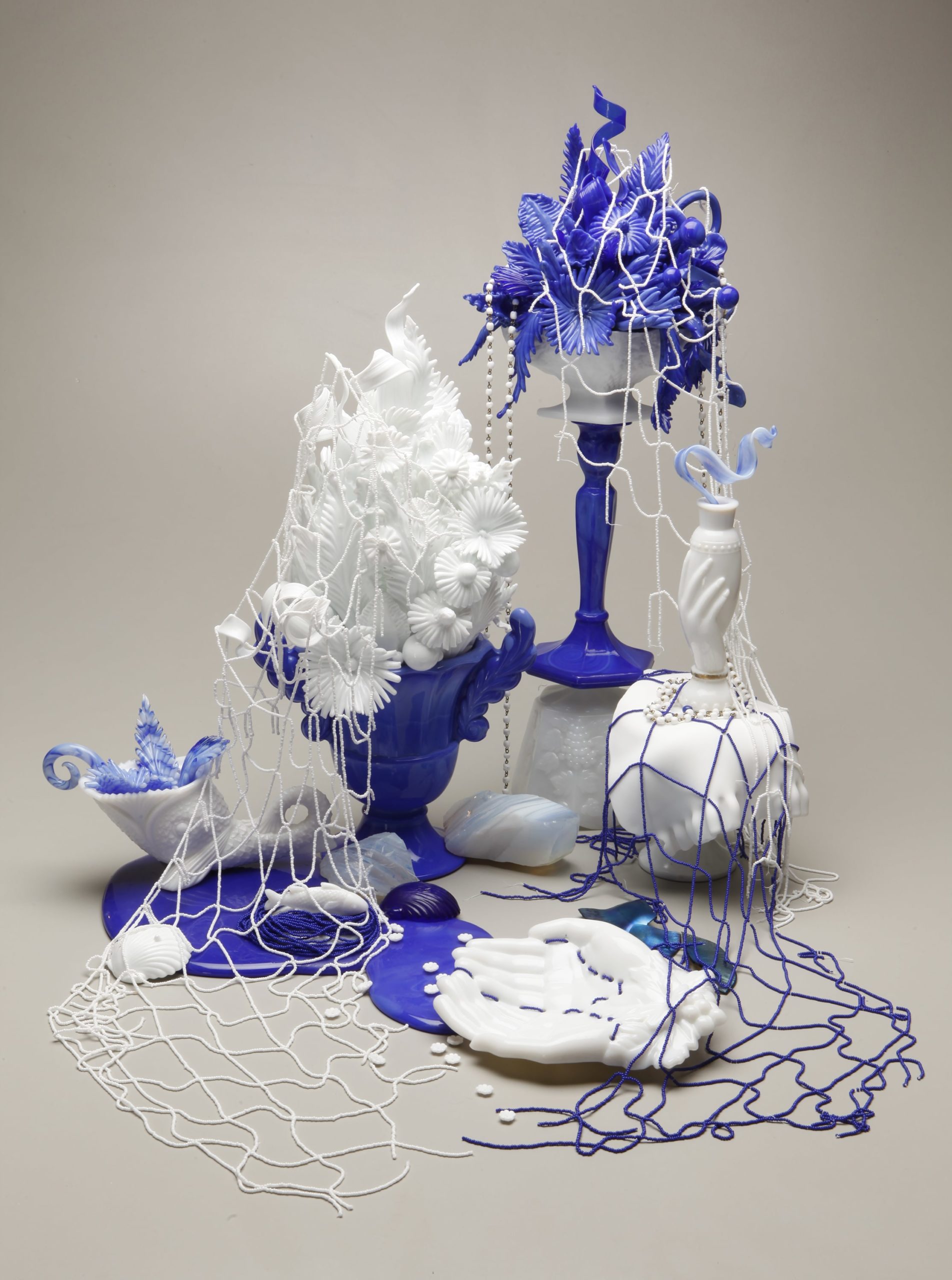
Amber Cowan’s commissioned piece for Daze and Maison Margiela, inspired by the fashion house’s recent collection and film, “A Folk Horror Tale.”
WW: How are you exploring the feminine and domestic nature of these antique glass pieces?
AC: This kind of glass, and maybe it’s having a little bit of a resurgence, actually, but it fell out of fashion for a very long time. It’s heavy, it reminds you of your grandmother, and maybe not in a good way, you know. It just wasn’t in fashion for a long time. I feel like by reinventing the material, it’s bringing it into a new conversation.
I don’t often use just whole found pieces. It’s more of a blend of old and new. It makes you think of that old material, but I don’t want it to look old-fashioned. I want it to look contemporary. That blend gives it history but also a new conversation.
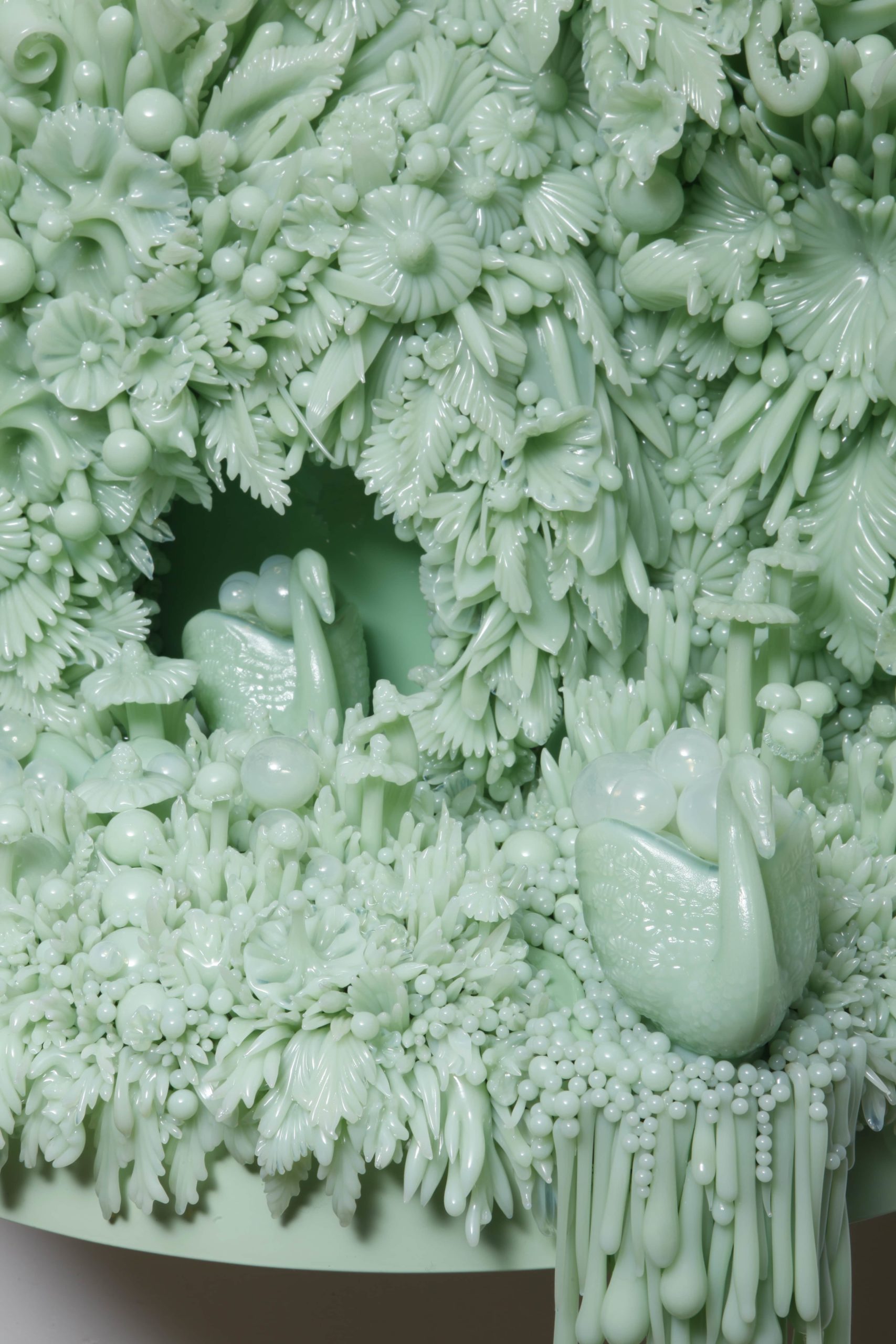
Amber Cowan, “Bubble Bath in the Tunnel of Love,” 2020, 25 x 25 x 15 inches, glass and Mixed Media, photo by Constance Mensh, courtesy of the artist.
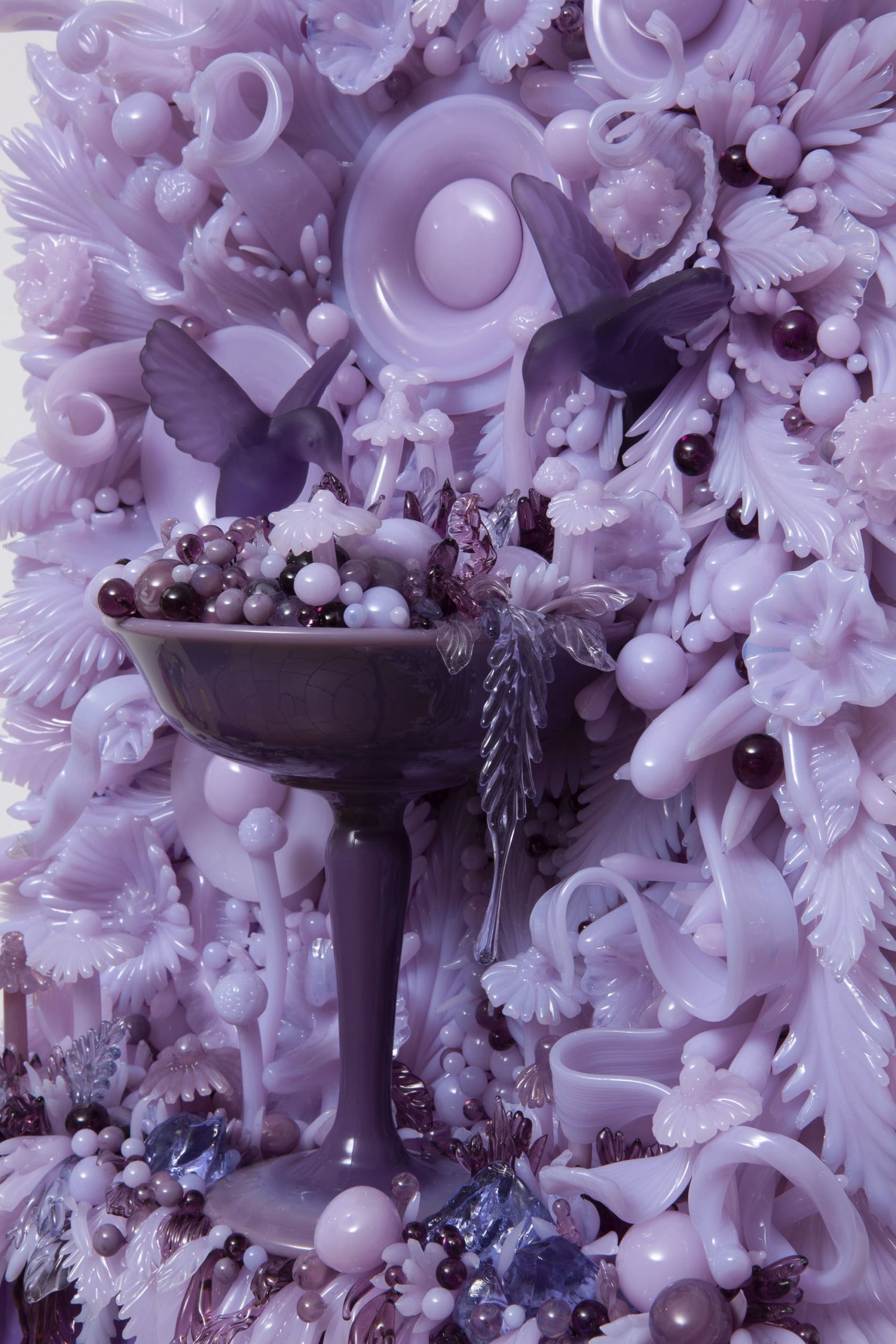
Amber Cowan, “Hummingbirds Feast on Helio and Lavender,” 2021, 20 x 15.5 x 7.5 inches, glass, Mixed Media, photo by Matthew Hollerbush, courtesy of the artist.
